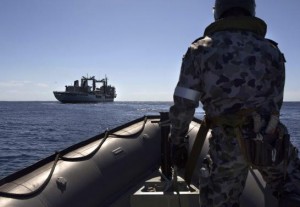
CREDIT: REUTERS/AUSTRALIAN DEFENCE FORCE/HANDOUT VIA REUTERS
(Reuters) – The search for missing Malaysia Airlines Flight 370 resumed on Wednesday, even as senior Australian officials warned that bad weather and a lack of reliable information were seriously impeding efforts to locate the plane’s wreckage.
Up to 10 planes and nine ships from a half dozen countries are scouring a stretch of the Indian Ocean roughly the size of Britain, where the plane is believed to have crashed more than three weeks ago.
The search and rescue teams are in a race against time to locate the plane’s black box recorder, which has an expected battery life of around 30 days and contains what could be the only clues about the plane’s mysterious disappearance.
But retired Air Chief Marshal Angus Houston, the head of the Australian agency coordinating the operation, said that a lack of reliable flight telemetry and punishing conditions at sea were making the operation even more challenging.
“In other words, we don’t have a precise aircraft location for six hours before the aircraft went into the water somewhere,” he said in an interview with the Australian Broadcasting Corporation on Wednesday.
“The reality is it’s the most complex and challenging search and rescue operation, or search and recovery operation now, that I’ve ever seen.”
Broken clouds, sea fog and isolated thunderstorms were expected to further complicate operations on Wednesday, Australia’s Joint Agency Coordination Centre said.
The search is now focused on an inhospitable 221,000 sq km (85,000 sq miles) swathe of the southern Indian Ocean some 1,500 km (932 miles) west of the Australian city of Perth. But despite the unprecedented effort, the international team has so far failed to spot any trace of the jetliner.
“Look, it’s one of the great mysteries of our time,” Australian Prime Minister Tony Abbott said in an interview with local Perth radio station Radio 6iX.
“We owe it to the world, we owe it to those families to do whatever we reasonably can do get to the bottom of this.”
NAJIB TO PERTH
Malaysian Prime Minister Najib Razak is expected to arrive in Perth late Wednesday to inspect the search and rescue operations, which are being conducted out of RAAF Base Pearce north of the city.
He will arrive with Malaysia coming under fresh fire for its handling of the incident after authorities there changed their account of the plane’s critical last communication from a more casual “All right, good night” to the standard “Good night Malaysian three seven zero.”
Malaysia on Tuesday released the full transcript of communications between the Boeing 777 and local air traffic control before it dropped from civilian radar in the early hours of March 8 as it flew from Kuala Lumpur to Beijing.








